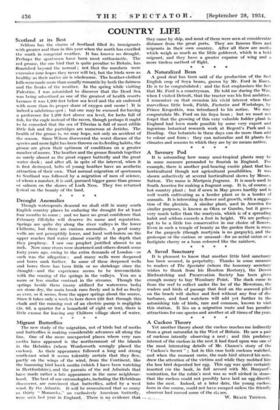Migrant Butterflies The new study of the migration, not of
birds but of moths and butterflies is making considerable advances all along the line. One of the more unexpected places where very rare moths have appeared is the • northernmost of the islands in the Hebrides (where Wordsworth wrongly placed the cuckoo). As their appearance followed a. long and strong south-east wind it seenis tolerably certain that they flew, partly on the wings of the wind, from the Continent, like the humming bird hawk moths (which I have been watching in Hertfordshire), and the parents of the red Admirals that have made rather a late appearance in the same neighbour- hood. The best of our entomologists, including the Hebridean discoverer, are convinced that butterflies, aided by a west wind, fly the Atlantic. It will be remembered that as many as thirty " Monarchs," an exclusively American butterfly, were seen last year in England. There is no evidence that
they came by ship, and most of them were seen at considerable distance from the great ports. They are famous fliers and migrants in their own country. After all there are moths which weigh as much as the little goldcrest, which is a bold migrant, and they have a greater expanse of wing and a more tireless method of flight.


















































 Previous page
Previous page